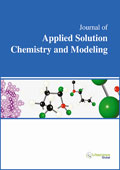jascm
|
|
Abstract: Viscosities which are accurate to ± 0.01mP, have been measured for binary liquid mixtures of acetylene tetrachloride (CHCl2CHCl2,hereafter abbreviated simply as ATC) with benzene, toluene, p-xylene, acetone and cyclohexane at 303.15 ±0.01K. The values of the quantity Δη, which refer to the deviations of the experimental values of the dynamic viscosities of the mixtures from the mole fraction mixture law values, have been found to be negative for the systems ATC-benzene, ATC-toluene, ATC-p-xylene and ATC-cyclohexane. For ATC-acetone, ∆η has been found to be negative at low mole fractions of ATC and positive at high mole fractions. Also the values of the parameter d have been calculated from the equation ln η = x1 ln η1+x2 ln η2 +x1 x2 d, where η1 & η2 refer to the dynamic viscosities of the two pure liquids 1 and 2 whose mole fractions in the mixtures are x1 & x2 respectively. The values of d indicate the existence of specific interaction of ATC with benzene, toluene, p-xylene and acetone. The viscosity data have been analysed in the light of absolute reaction rate and free volume theories of liquid viscosity. Keywords: Acetylene tetrachloride, benzene, toluene, specific interactions, viscometer, hydrogen bonding.Download Full Article |
|
|
Abstract: Variation of the activation parameters for the aminolysis in the SN2, acyl-transfer, SNAr and AdN reactions offers an additive mechanistic tool for the studies of these reactions in solution. This approach uses the substituent effects on the benzene and pyridine rings to the variation of the activation parameters, ΔX≠ (X = H, S, G), in the above reactions in the frameworks of the Hammett – like equations in order to evaluate the resultant δΔX≠ reaction constants. The single linear dependences of the internal enthalpy constants δΔH≠int on the δΔG≠ and the Hammett ρ constants show that the substituent effects in the leaving and nonleaving groups and nucleophiles on the mechanistic features in aminolysis of bimolecular nucleophilic reactions are governed by the magnitude of δΔH≠int when one of the steps of the process is the single rate-determining step. Keywords: Aminolysis in solution, nucleophilic reactions, activation parameters, reaction mechanism.Download Full Article |
|
|
Abstract: In the present review the percolative phenomena has been analyzed. Percolation is related to transport phenomena in microemulsions, in particular the electric charge transport. The influence of different additives upon electric percolation has been commented. The effects of the additives considered upon the microemulsion properties appear to come about through their association with the surfactant interface. The effects of these agents on the ease with which interdroplet channels allowing transfer of droplet contents are formed are not only responsible for their effects on percolation temperature, but also have serious implications for the rates of fast chemical reactions performed in microemulsions. Keywords: Microemulsion, Surfactants, Transport phenomena, Percolation, Aditives, Percolation Temperature.Download Full Article |
|
|
Abstract: The consequences for the transfection efficiencies of different lipoplexes preparation methods, largely remain to be explored, but the knowledge of how different experimental approaches can affect the physicochemical properties and transfection efficiency is essential for a proper tailoring of transfection complexes to particular applications. Therefore, the influence of the number of mixing steps (one-step addition versus multi-step addition of liposomes to plasmid DNA (pDNA)) and lipoplex incubation temperature on the final physicochemical properties and transfection efficiency of pDNA/ Dioctadecyldimethylammonium Bromide (DODAB):1-monooleoyl-rac-glycerol (MO) complexes was studied in three distinct DODAB:MO molar ratios: 4:1, 2:1 and 1:1. Dynamic Light Scattering (DLS), Zeta (ζ) Potential, Ethidium Bromide (EtBr) exclusion assays were used to assess the formation, structure and destabilization of the lipoplexes, whereas in vitro transfection assays with pSV-β-gal plasmid DNA were performed to evaluate their transfection efficiency on the 293T mammalian cell line. Results indicate that the morphology of pDNA/DODAB:MO complexes is dependent on the lipoplex preparation method, resulting in particles of distinct size, surface charge and membrane fluidity. These variations are visible during the complexation dynamics of pDNA and continue throughout the profile of pDNA release from pDNA/DODAB:MO lipoplexes upon incubation with Heparin (HEP), as well as in the in vitro transfection assays. The stepwise addition of DODAB:MO vesicles to pDNA decreases the transfection efficiency of the lipoplexes, while the effect of the lipoplex preparation methods is dependent on the MO content. Keywords: Monoolein-Based Lipoplexes, Lipoplex Preparation Method, Transfection.Download Full Article |
|
|
Abstract: Excess molar volumes have been measured by means of a dilatometer for tetrachloroethylene (TCE) +acetyl acetone, + acrylonitrile, +anisole and+ tetrahydrofuran at 303.15 K. VEm values are positive over the entire range of composition for TCE- anisole and TCE – acetyl acetone and negative for TCE- Tetrahydrofuran. For TCE – acrylontrile, VEm has been found to be negative up to x = 0.8379 and positive onward. Values of VmE for the various systems have been fitted by the method of least squares with smoothing equation, and have been discussed from the viewpoint of the existence of specific interactions between the components. Keywords: Tetrachloroethylene, dilatometer, excess volume, specific interaction.Download Full Article |


